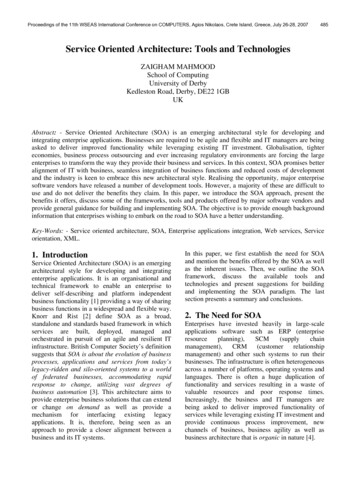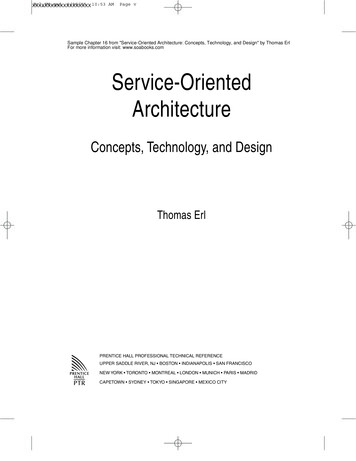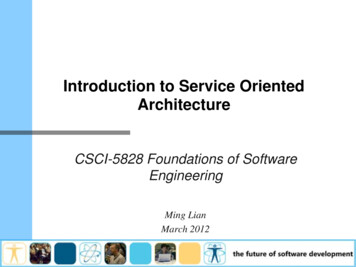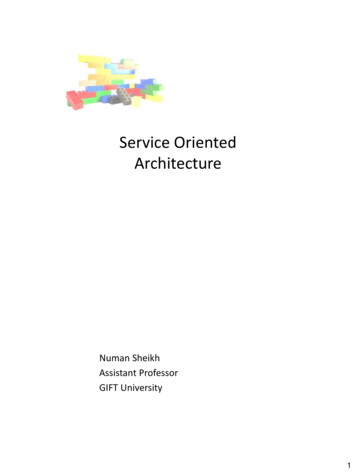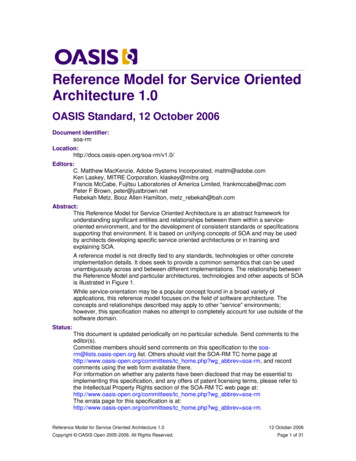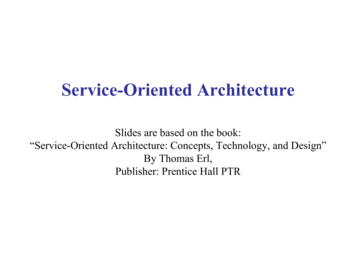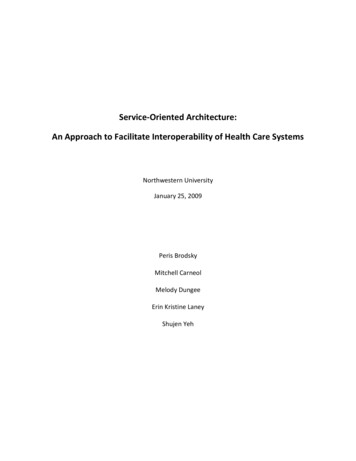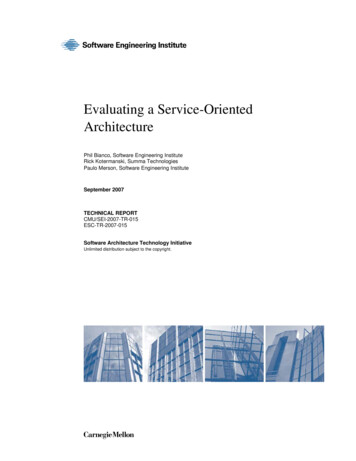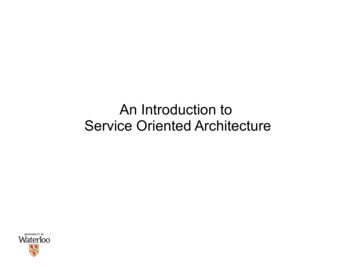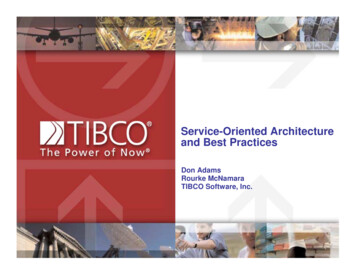
Transcription
Service-Oriented Architectureand Best PracticesDon AdamsRourke McNamaraTIBCO Software, Inc.
Agenda2! What is SOA15 minutes! Architecture1 hour! Standards45 minutes! Best practices45 minutes! Q&A30 minutes 2006 TIBCO Software Inc. All Rights Reserved. Confidential and Proprietary.
Services: The Big Picture! What is a service?! A commonly used unit of functionality! e.g. Sales Order Management! Packaged for easy access and consistent re-use! Becomes a de-facto standard in the enterprise! Services are all about reuse and ROI! Avoid re-inventing the wheel on the next project! ROI from IT cost reduction! Assemble new business processes from existing services! ROI from faster time-to-market – a more responsive enterprise! The functionality underlying most services already exists! We’re making it more accessible! Integration is essential! It takes discipline and governance to get the ROI from services! To build the right services and ensure they are reusable! To ensure that they actually get used! To operate and evolve the services once deployed3 2006 TIBCO Software Inc. All Rights Reserved. Confidential and Proprietary.
The Enterprise Challenges with SOAProductivityControlSOADeliver morefunctionalityIn less timeAt a lower nect newapplications toexisting IT investments4 2006 TIBCO Software Inc. All Rights Reserved. Confidential and Proprietary.
IT Pain Points Addressed by SOA71%More flexible architectureIntegration to existing applications67%Data integration62%59%Service integrationComposite application development53%Enterprise portal initiatives49%46%Business management process implementationsService management and governanceOther technology initiatives39%1%0%10% 20% 30% 40% 50% 60% 70% 80%Q: What are the IT/technology problems your company hopes to address using SOA?Base: 521 (Among qualified respondents)Source: InfoWorld Research Report: Service Oriented Architecture (SOA), March 20065 2006 TIBCO Software Inc. All Rights Reserved. Confidential and Proprietary.5
Top 3 Drivers for SOA Segmented by IndustryBusiness DriversCompetitive advantageFinancialServicesManufacturingTransport &Comm Utilities Revenue growth Internal operational / processefficiencyRetail /WholesaleHealthcareServicesGov’t &Education Services External process efficiencyIT DriversSupport dynamic businessenvironment Optimal use of IT resourcesUpgrade company’s ITinfrastructureLong term cost savingsShort term cost savings Source: IDC “SOA-Based Services Buying Trends: A 2006 Survey of U.S. Companies” May 2006 (sampling 447 qualified respondents weighted by size of company )6 2006 TIBCO Software Inc. All Rights Reserved. Confidential and Proprietary.
SOA Speeds Time to Market! SOA leverages existingapplication componentsinstead of writing and testingnew code! This can shorten the length ofthe average applicationdevelopment project –perhaps as much as 75%Source: Tutorial: How to Build a Cost Model for Service-Oriented Development ofApplications, Michael Blechar, Gartner Application & Web Services Summit, April 2005“More than 75% of enterprise applications inproduction are monolithic. Their business logic isnot externally accessible in a modular form foreasy reuse in other applications.”Gartner Integration Conference, May 20047 2006 TIBCO Software Inc. All Rights Reserved. Confidential and Proprietary.
The ROI: SOA Can Reduce an Organization’s IT Budget! Service-oriented development of applications (SODA) is estimated toreduce total IT expenses over the long term by as much as 20%compared to traditional client/server development methods! Savings becomes exponential over time as library of business servicesexpands and greater degree of reuse is achievedAnalysis compares cost savings usingthree types of Service-OrientedDevelopment of Applications (SODA)when compared to traditionalclient/server application development:RAD Rapid Application DevelopmentAMD Architected Model-DrivenARAD Architected Rapid ApplicationDevelopmentSource: Tutorial: How to Build a Cost Model for ServiceOriented Development of Applications, Michael Blechar,Gartner Application & Web Services Summit, April 20058 2006 TIBCO Software Inc. All Rights Reserved. Confidential and Proprietary.
SOA Enables a New Breed of “Recomposable” ApplicationsSOA creates an architecture style that enables you to composeapplications out of reusable servicesThe ROI goes beyond ITcost reduction:ProcessOrderNew Composite Service or ApplicationPlaceOrderAlertLargeOrder! Increased reuse,! Greater flexibility, and! Greater productivityyieldCompositeService or ustomer 2006 TIBCO Software Inc. All Rights Reserved. Confidential and Proprietary.IssueInvoiceProcessOrder! Faster time to market!9NotifyCustomerNotifyCustomer
Integration is an Essential Ingredient –SOA is Heterogeneous and DistributedJavaApplication PlatformsUsed for SOA61%.NET60%J2EE54%C/C 24%COBOL8%Other Mainframe8%Extremely DifficultThe Challenge ofDeploying AcrossApplication Platforms16%Somewhat Difficult73%Not at all DifficultDon't Know8%3%Source: InformationWeek 2006 Survey10 2006 TIBCO Software Inc. All Rights Reserved. Confidential and Proprietary.
But We Need Governance to Realize Benefits:24% of Companies say SOA Fails to Meet ExpectationsThe Reasons Given Why SOA Fell ShortIntroduced more complexity intoIT system55%Cost more than expected41%Failed to provide expected levelof integration35%Needed standard just emergingor not yet on drawing boardsToo expensive to integratelegacy systems0%10%20%34%24%30%40%Source: InformationWeek 2006 Survey11 2006 TIBCO Software Inc. All Rights Reserved. Confidential and Proprietary.50%60%
So What Does it Take to Succeed?! Architecture! Organization and Governance! Standards! And of course Best Practices!12 2006 TIBCO Software Inc. All Rights Reserved. Confidential and Proprietary.
SOA Architecture
A Business Process Built with Services14 2006 TIBCO Software Inc. All Rights Reserved. Confidential and Proprietary.
Services are More Than Operations!! The responsibilities of a service often extend beyond a singleoperation! The Order Management Service keeps track of the full life-cycle ofthe order! Its operations step the order through its life-cycle! The Submit Order Operation creates the order! The Update Status Operation allows other parts of the business process toupdate the order status15 2006 TIBCO Software Inc. All Rights Reserved. Confidential and Proprietary.
Pure Request-Reply Operations Are Not Enough!!When we order on-line, the goods do not arrive while we aresitting at the computer (most of the time, at least)!!There is service activity after the order acknowledgement isreturned!!E.g. the release of the order to the warehouse for fulfillmentThe service can generate asynchronous responses!!!Other operations interact with work-in-progress!16E.g. status updatesE.g. get order status, update status, etc. 2006 TIBCO Software Inc. All Rights Reserved. Confidential and Proprietary.
Event Notification Decreases Coupling! In request-reply, the requestor specifies the operation to beperformed! Requires the requestor to know what operations need to be performed by whichparticipants! Notification provides a design alternative! The “Notification Service” announces that an event has occurred! i.e. the order has shipped! The “Subscriber” to the notification service decides on its own what to do when thenotification is received! i.e. the Accounts Receivable Service sends an invoice17 2006 TIBCO Software Inc. All Rights Reserved. Confidential and Proprietary.
Typical Service Architecture! Services provide ease of access by standardizing:! Access technology! Data semantics (common data model)! Operation semanticsUsingComponentUsingComponent 18Some level ofstandardization Technology of access Data semantics Operation semanticsServiceInterfaceServiceNative semantics foroperation and dataNative technology foroperation and data NativeInterfaceNativeInterfaceProvider ofFunctionalityProvider ofFunctionalityTraditional Object/ComponentApproachService Approach 2006 TIBCO Software Inc. All Rights Reserved. Confidential and Proprietary.Native semantics foroperation and dataNative technology foroperation and data
Not Every Service Needs Full Standardization! Standard TIBCO adapters ease access to legacy applications! Standardize access technology! Native semantics for data structures and operations! Relies on communications infrastructure for security aspects! XML Common Data Model over RV or JMS! Standardize access technology and data structure semantics! May or may not standardize operation semantics! Relies on communications infrastructure for security aspects! Full-blown SOAP! Standardize access technology, standardize data structure and operation semantics! Provides security aspects independent of communications infrastructure! Requires a security infrastructure, however!We need to be clear about the standardization goals for each serviceIt is valid to have different standardization goals for different services!19 2006 TIBCO Software Inc. All Rights Reserved. Confidential and Proprietary.
Infrastructure Services! Building blocks that provide commonly required functionality in astandardized way! Exposing lower level functionality as services significantly reduces thelevel of effort required to build higher level services! Common infrastructure services include:! Messaging Services! Event Services! Audit and Logging Services! Error Notification Services! Security Services! Portal Services! These are typically not SOAP services!! They are used to implement other services20 2006 TIBCO Software Inc. All Rights Reserved. Confidential and Proprietary.
Complete Uniformity is Not Always terfaceErrorAnnunciationService!Sometimes a re-usablecomponent (library) needs to beprovided in the user’s technologyand embedded!Examples:! Local interface for error logging! Security intercept for access InterfaceCentralizedLoggingServiceError ativeInterfaceError DisplayConsole21 2006 TIBCO Software Inc. All Rights Reserved. Confidential and Proprietary.
Standardize Service Transports! Select transports thoughtfully - these will become yourstandards! Mistakes will be expensive to correct! Don’t expect to get to a single standard!! A single standard may be counter-productive! You get the ROI from minimizing the variations! Common pattern: HTTP for interactions outside the enterprise,JMS within the enterprise22 2006 TIBCO Software Inc. All Rights Reserved. Confidential and Proprietary.
Choose Your Service Transports CarefullyUse (SOAP over) HTTP:Use (SOAP over) JMS:! When HTTP is already used or theaccepted standard. Don’t reinventthe wheel unless necessary! For asynchronous messaging! When zero client install is arequirement (e.g. portals or Webclients)! For external services wheninstalling JMS clients is not anoption! For publish/subscribe! For intermittently connectedsystems or devices! For exactly-once delivery (e.g.mission-critical applications)! For high volume and scalabilityConsider JMS as the default bus forinternal applicationcommunication23 2006 TIBCO Software Inc. All Rights Reserved. Confidential and Proprietary.
Point-to-Point Services!Point-to-Point Servicesstandardize the technologyused to access operationsand represent dataUsingComponent !Point-to-Point services do notstandardize the semantics of theoperation or the data. ServiceInterfaceData orApplicationServiceNativeInterfaceProvider ofFunctionality24 2006 TIBCO Software Inc. All Rights Reserved. Confidential and Proprietary.Native semantics foroperation and dataStandard technology foraccess
Business Services!Business services standardizeboth the semantics and the accesstechnology!The standardization greatlysimplifies the reuse of thefunctionality in many contexts!This standardization also makes iteasier to construct or modifycomposite business servicesUsingComponent ServiceInterfaceDataTransformation,Other ceNativeInterfaceProvider ofFunctionality25 2006 TIBCO Software Inc. All Rights Reserved. Confidential and Proprietary.Standard semantics fordata and operationStandard technology foroperation and data
Service Composites! Service composites orchestrate the use of services to achieve somegoal! The composite may, itself, be a service! A composite may be a complete business process, giving us BusinessProcess Management! BPM and Business Works can be viewed as tools for creating composites! Service composites make possible the overall management of theencapsulated business process including monitoring and errorreporting26 2006 TIBCO Software Inc. All Rights Reserved. Confidential and Proprietary.
What Secondary Functions Might a Service Provide?! Control over who has access (authorization)! Validation of the user’s credentials (authentication)! Accounting regarding who is using the service! Audit trail! Bill-back for service utilization! Encryption/Decryption (only half!)! Non-repudiation! Performance tracking! Rates of utilization! Response timeDifferent services may require different levels of secondary functions!27 2006 TIBCO Software Inc. All Rights Reserved. Confidential and Proprietary.
Services Are Not Free!! More work at design time! Increased levels of documentation and testing are required! Access overhead! Granularity of work must outweigh overhead! We don’t make addition into a service! There are other ways to obtain reuse (e.g. shared code libraries)! Extra work at run-time! Authentication, authorization, encryption, accounting, audit trails! Every interface shouldn’t be a service!! Must demonstrate potential for reusability (i.e. ROI) to justify! Identify the multiple users of the service! Make sure that the functionality is, indeed, the same!28 2006 TIBCO Software Inc. All Rights Reserved. Confidential and Proprietary.
Specifying Services! Common functionality used in several use cases can be packaged as a service! The operations of the service should be documented as distinct use cases! Same use case definitions apply! Asynchronous event trigger (now indirect, via business use case trigger)! Trigger initiates a chain of activity! Activity produces a countable result! Ex: Consider “Obtain Disbursal Authorization”! The transfer funds use case also needs this capability if the funds transfer is between banks! Define “Obtain Disbursal Authorization” as an implementation use case29 2006 TIBCO Software Inc. All Rights Reserved. Confidential and Proprietary.
ATM Example Services30 2006 TIBCO Software Inc. All Rights Reserved. Confidential and Proprietary.
Scenario Showing Service Design in ContextCustomer:PersonATM MachineATM ServerBankinsert card and enter PINvalidate PIN(card data, PIN)prompt for transaction(prompt)select "Withdraw Cash"prompt for amount(selected transaction)enter amount(prompt for amount)invoke remove cash(removal notice)remove card and receipt31YesDispense Cashinvoke report fundsdelivered serviceprint receipt andreturn card(disbursal request)Determine Bankand Forward(disbursal authorization)(dispensing notification)Determine Bankand Forward(notification acknowledgement)(card, receipt) 2006 TIBCO Software Inc. All Rights Reserved. Confidential and Proprietary.(forwarded request)grant disbursalauthorization(disbursal authorization)(forwarded notificaton)record withdrawaltransaction(notification acknowledgemnet)
Scenario Showing Use of ServiceCustomer:PersonATM Machineinsert card and enter PIN(card data, PIN)validate PINprompt for transaction!The disadvantage of thisapproach is that you losethe big picture of how allthe components interact tocarry out the functionselect "Withdraw Cash"(selected transaction)enter amount(amount)(prompt)prompt for amount(prompt for amount)invoke obtaindisbursalauthorization serviceSee dusbursalauthorizationservice fordetailsSuccess?(cash)remove cashYesDispense Cashinvoke report fundsdelivered service(removal notice)print receipt andreturn cardremove card and receipt32(card, receipt) 2006 TIBCO Software Inc. All Rights Reserved. Confidential and Proprietary.See fundsdeliveredservice fordetails
Service Design Specification! Each overall service should be characterized by specifying:! The abstraction level! The unit of work life-cycle the service encapsulates! All the states an order can go through! The operations provided by the service! Place order, modify order, cancel order, get order status! The data the service actively manages! What was ordered, shipping address, payment terms, etc.! Ancillary data required by the service! Customer information, product information! The relationship between the service and lower-level services on which the servicedepends! Key Performance Indicators (KPIs) and Service Level Agreements (SLAs)! Audit requirements for the service33 2006 TIBCO Software Inc. All Rights Reserved. Confidential and Proprietary.
Service Operation Specification! Each operation of the service should be characterized by specifying:! The operation interface! The semantics of the operation being invoked.! What changes does it make that are visible?! The input and output data structures and their semantics! Performance requirements! The required availability of the operation! The invocation style for the service! On-demand, event driven, continuous! The coordination approach used! Fire-and-forget, request-reply, etc.! Authentication required! Authorization required! Data protection (encryption) required34 2006 TIBCO Software Inc. All Rights Reserved. Confidential and Proprietary.
You Will Never Build a Perfect Service!! Be happy if you get close enough that the changes are minor! E.g. adding a field here or there! Plan for service evolution! Infrastructure must allow the simultaneous deployment of both old and new serviceversions! Service users can gradually convert to the new version35 2006 TIBCO Software Inc. All Rights Reserved. Confidential and Proprietary.
SOA OrganizationalIssues
The Reusability Challenge! How do we design for future usages?! Today we enter orders in person, via paper, by phone, on-line, ! What’s next – via Blackberry? Automatic re-order?! Your CPG firm decides to sell branded clothing as a promotion!! Orders now need sizes, colors, etc.! Insight is required when conceptualizing a service! What might change in the future?! Evolutionary changes – organic growth! Revolutionary changes – buying your biggest competitor, new markets! How do these changes challenge existing functionality?! Which alternatives are worth investing in?Who can provide this insight in your organization?37 2006 TIBCO Software Inc. All Rights Reserved. Confidential and Proprietary.
Business and Infrastructure Services Differ!!!Infrastructure Services encapsulate portions of system processes!E.g. “Report error” or “Make Audit Entry”!The requirements come from the technical community!The users are future technical projectsBusiness Services encapsulate portions of business processes!e.g. “Place Sales Order” or “Invoice Customer”!The requirements come from the business community!The users are future business processesDifferent organizations are involved!38 2006 TIBCO Software Inc. All Rights Reserved. Confidential and Proprietary.
The Silo Problem – Who Owns the Big Picture?ServiceInterfaceData ca
Service-oriented development of applications (SODA) is estimated to reduce total IT expenses over the long term by as much as 20% compared to traditional client/server development methods! Savings becomes exponential over time as library of business services

